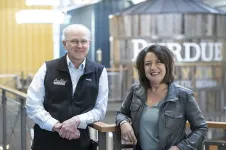(Press-News.org) The function of mast cells, which are part of the immune system, is still a mystery. Scientists at the German Cancer Research Center (DKFZ) have now shown in mice: mast cells function as a sensor that signals the animals to avoid antigens, including harmful allergens, and thereby protect themselves from health-threatening inflammatory reactions. The findings were published in the journal Nature.
Mast cells are found primarily in tissues that separate the outside and inside worlds of the body, such as the epithelia of the gastrointestinal tract and lungs. Within the tissues, mast cells often reside near nerve endings. Mast cells are well known to persons suffering from allergies because they secrete messenger substances such as histamine, which cause annoying to health-threatening allergic symptoms. These symptoms occur when mast cells are activated by IgE class antibodies during repeated antigen contact.
"Why mast cells and IgE exist at all has not yet been conclusively explained," says Hans-Reimer Rodewald. The DKFZ immunologist and his team have now been able to show for the first time in mice, in a combination of behavioral experiments and immunological studies, that mast cells act like a sensor that helps to avoid contact with allergens
No antigen avoidance without mast cells and IgE
The DKFZ researchers immunized mice with the allergen ovalbumin, a protein component of chicken egg white. They then gave the animals the free choice of preferring either normal or egg white-containing drinking water. Immunized animals avoided the egg white-enriched water, while their non-immunized conspecifics clearly preferred it. A large proportion of the immunized animals avoided the egg white-containing water already one day after immunization, some mice even after the first sip.
However, when the scientists performed this behavioral test with mice that genetically lack mast cells, both immunized and non-immunized animals preferred the egg white-containing water. Mice genetically unable to produce IgE also showed no avoidance behavior. Thus, both components - mast cells and IgE - are responsible for antigen avoidance.
When the immunized mice had no choice because the egg white solution was instilled in them, the animals developed inflammation in the stomach and small intestine. "The avoidance behavior mediated by mast cells apparently protects the animals from harmful immune reactions," explains Thomas Plum, one of the first authors.
How do mast cells "talk" to the brain?
An important open question for the scientists was now: How can mast cells, as a component of the immune system, influence behavior? In what ways do immune cells "talk" to the brain? The scientists examined a variety of biologically active substances released by mast cells. These include leukotrienes, pro-inflammatory messengers known to activate sensory nerves. If the researchers blocked leukotriene synthesis, the immunized mice no longer showed the same consequence in avoiding egg white. Leukotrienes therefore appear to be at least partly involved in avoidance behavior. Further immunological and neurobiological experiments are needed in the future to identify the nerve connections through which the mast cell signal is reported to the brain.
"In the intestine, lungs or skin, immune reactions against non-infectious antigens can occur as a result of so-called barrier disorders, permeability of the tissues from the outside to the inside. In the case of allergy, we call such antigens allergens. Whether these substances are dangerous or not, it is important for the organism to avoid their further intake in order to prevent inflammatory diseases. This is an evolutionary advantage and finally a conclusive explanation of the physiological role of mast cells and IgE," Rodewald summarizes the results.
Whether mast cells also contribute to the avoidance of harmful antigens in humans must be adressed in further studies.
Thomas Plum, Rebecca Binzberger, Robin Thiele, Fuwei Shang, Daniel Postrach, Candice Fung, Marina Fortea, Nathalie Stakenborg, Zheng Wang, Anke Tappe-Theodor, Tanja Poth, Duncan MacLaren, Guy Boeckxstaens, Rohini Kuner, Claudia Pitzer, Hannah Monyer, Cuiyan Xin, Joseph V. Bonventre, Satoshi Tanaka, David Voehringer, Pieter Vanden Berghe, Jessica Strid, Thorsten B. Feyerabend & Hans-Reimer Rodewald: Mast cells link immune sensing to antigen avoidance behaviour.
Nature 2023, DOI: https://www.nature.com/articles/s41586-023-06188-0
END
Mast cells as a sensor: Enigmatic immune cells help to avoid harmful allergens
2023-07-12
ELSE PRESS RELEASES FROM THIS DATE:
Detailed map of the heart provides new insights into cardiac health and disease
2023-07-12
In a new study, published today (12 July) in Nature, researchers have produced the most detailed and comprehensive human Heart Cell Atlas to date, including the specialised tissue of the cardiac conduction system - where the heartbeat originates.
The multi-centre team is led by the Wellcome Sanger Institute and the National Heart and Lung Institute at Imperial College London, and has also presented a new drug-repurposing computational tool called Drug2cell, which can provide insights into the effects of drugs on heart rate.
This study is part of the international Human Cell Atlas* ...
Second year of COVID pandemic brought spike in child mental health visits to ED
2023-07-12
The number of young people in the United States visiting hospital emergency departments for mental health crises increased sharply during the second year of the COVID-19 pandemic, according to a study led by researchers from the Department of Health Care Policy in the Blavatnik Institute at Harvard Medical School. The findings are published Jul 12 in JAMA Psychiatry.
These results come amidst growing national concern about a crisis in youth mental health and provide important new details about how young people with mental health problems such as self-harm ...
Global study details microplastics contamination in lakes and reservoirs
2023-07-12
LAWRENCE, Kan. — Around 14 million tons of plastic end up in the ocean every year. But that is not the only water source where plastic represents a significant intrusion.
“We found microplastics in every lake we sampled,” said Ted Harris, associate research professor for the Kansas Biological Survey & Center for Ecological Research at the University of Kansas.
“Some of these lakes you think of as clear, beautiful vacation spots. But we discovered such places to be perfect examples of the link between plastics and humans.”
Harris ...
A foundation that fits just right gives superconducting nickelates a boost
2023-07-12
Researchers at the Department of Energy’s SLAC National Accelerator Laboratory and Stanford University say they’ve found a way to make thin films of an exciting new nickel oxide superconductor that are free of extended defects.
Not only does this improve the material’s ability to conduct electricity with no loss, they said, but it also allows them to discover its true nature and properties, both in and out of the superconducting state, for the first time.
Their first look at a superconducting nickel oxide, or nickelate, that does ...
New study using human fibroid cells supports use of green tea compound as treatment for uterine fibroids
2023-07-12
In a pre-clinical, proof-of-concept study from Johns Hopkins Medicine, researchers found that epigallocatechin gallate (EGCG), a green tea compound with powerful antioxidant properties, could be promising for both treating and preventing uterine fibroids. Results of the study, first posted online May 25 in Scientific Reports, add to growing evidence that EGCG may reduce fibroid cell growth. The study was specifically designed to identify the biochemical mechanisms responsible for EGCG action in fibroid cells.
The investigators emphasize that their study involves human fibroid cells grown in the laboratory and treated with EGCG extract to explore the possibility of oral EGCG supplementation ...
The good advice that could lift people out of poverty
2023-07-12
Providing access to housing, debt, and benefit advice within food banks could help lift people out of poverty - according to a University of East Anglia study.
Researchers worked with Norwich Foodbank centres, part of the Trussell Trust, on a pilot project that saw representatives from Citizens Advice and Shelter posted within the service.
The ‘Making a Difference’ initiative meant that people forced to use a food bank were also able to access advice on a range of issues - from housing and debt to benefits.
It is now hoped that this scheme will be rolled out to foodbanks nationally.
Lead researcher Dr Sarah Hanson, from UEA’s School of ...
Amplified Sciences receives $400,000 NCI grant to improve early detection of pancreatic cancer
2023-07-12
WEST LAFAYETTE, Ind. – Health care providers and their patients could know with greater confidence whether pancreatic cysts are benign or potentially malignant, and if surgery is required to remove them, by using a new diagnostic test currently in development.
Amplified Sciences, a clinical-stage life sciences diagnostic company that licenses Purdue University innovations, has received a Phase I Small Business Innovation Research, or SBIR, grant of approximately $400,000 from the National Cancer Institute (NCI) to develop the test. The company focuses on accurately detecting and categorically assessing the risks of debilitating ...
Birmingham start-up awarded funding for technology that generates water out of air
2023-07-12
NovNat Tech Ltd, a visionary new company based in the Unit 9 incubator at the Birmingham Research Park, has secured funding from Innovate UK to develop a novel technology that can generate water out of air.
NovNat Tech is offering solutions to one of the most critical problems of today and the future, the global water scarcity crisis, and is developing a first of its kind ‘atmospheric water harvester’ to help address the global water shortage.
The harvest uses a proprietary material that has already been ...
Webb celebrates first year of science with close-up on birth of sun-like stars
2023-07-12
From our cosmic backyard in the solar system to distant galaxies near the dawn of time, NASA’s James Webb Space Telescope has delivered on its promise of revealing the universe like never before in its first year of science operations. To celebrate the completion of a successful first year, NASA has released Webb’s image of a small star-forming region in the Rho Ophiuchi cloud complex.
“In just one year, the James Webb Space Telescope has transformed humanity’s view of the cosmos, peering ...
Lupus Research Alliance announces recipients of 2023 Diversity in Lupus Research Awards
2023-07-12
NEW YORK, NY, July 12. The Lupus Research Alliance is pleased to announce the 2023 recipients of the Career Development and Postdoctoral Awards to Promote Diversity in Lupus Research. The Diversity in Lupus Research Awards aim to foster the development of outstanding, underrepresented minority scientists and establish a diverse community of researchers and clinicians in the field of lupus.
Lupus is a debilitating autoimmune disorder, and the prevalence, severity of symptoms, and mortality are higher among people of color. Yet a recent report by the National Science Foundation showed that while “Blacks or African Americans, Hispanics or Latinos, ...



